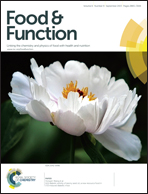Calycosin induces apoptosis by the regulation of ERβ/miR-17 signaling pathway in human colorectal cancer cells
Abstract
Prior studies have suggested that a high intake of isoflavonoids is associated with a protective effect against hormone-related cancers, such as colorectal cancer (CRC). Calycosin, a main component of isoflavones, has been shown to suppress the growth of hormone-dependent tumors through an ERβ-mediated signaling pathway. However, the effects of calycosin on CRC remain unclear. In this study, we aimed to investigate the anti-tumor activities of calycosin on CRC and its potential mechanism. HCT-116 cells were treated with calycosin. Cell proliferation, apoptosis and invasiveness were measured by MTT assay, flow cytometry and transwell invasion assay, respectively. mRNA levels of ER beta (ERβ) and miR-17 were quantified by real-time PCR. Protein expressions of ERβ and phosphatase and tensin homolog deleted on chromosome ten (PTEN) were determined by western blotting. We found that calycosin significantly induced apoptosis, and inhibited proliferation and invasiveness of HCT-116 cells in a dose-dependent manner. In addition, ERβ expression significantly increased in calycosin-treated HCT-116 cells, followed by a decrease of miR-17, and up-regulation of PTEN. Our results indicate that calycosin has an inhibitory effect on CRC, which might be obtained by ERβ-mediated regulation of miR-17 and PTEN expression.


 Please wait while we load your content...
Please wait while we load your content...